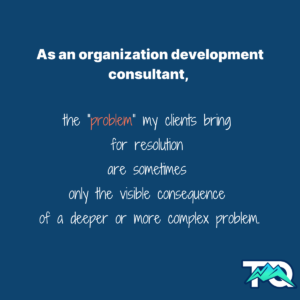It may sound radical, even risky…but consent helps teams move forward faster, align to values, and build trust while doing the work.
Who decides in your organization? …in your team? ….in your family?
And how is that working for you? For the work that needs to be done? For the moment that would best serve the group?
While top-down decision making is most common–and the belief I held when I started my career–this method often does not include the expertise, desires, and needs of those impacted by these very decisions.
Instead, I advocate for an inclusive, effective decision-making method: consent.
Scared? Let’s walk through what it is and how it can help.
What is consent decision-making?
Consent is when everyone in the group agrees that one specific proposal or idea is “Good enough for now and safe enough to try.”
Consent does not mean that everyone loves the idea; rather, everyone agrees that the proposal is within the boundaries of the group’s shared goal and within their tolerance of what is acceptable, bearing the group goal in mind.
Consent Decision-making happens well when:
- the group’s/team’s goal is clear
- the topic on the table does not contradict that goal
- any/all team members can object and stop the decision
- the Facilitator provides clarity and structure to the process
- resolving an objection will improve the proposal and enhance the proposal/options
YET – if we stop there, the list would be incomplete. We also need to consider an organization’s values and team dynamics.
For example: a team member of an Environmental Sustainability organization proposes generating sponsorship for their annual event. If this proposal were consented to, but the Sponsors who come forward are those who produce and sell products with chemicals that harm the soil, that would be a clear violation of the organization’s values–not to mention the additional ramifications of the organization’s credibility.
Another example: one team member is not on board with the proposal; they have objected. If the Facilitator were to shut down the objection with ‘not allowed,’ that would signal to all team members that we do not practice what we say we practice and therefore cannot be trusted. And of course the individual would likely feel many different unhelpful but very real emotions: devalued; minimized; singled out….
Instead, the Facilitator has many options to apply that involve understanding the objection to determine if it is relevant to the team’s goal and if so, to explore what else would make the proposal safe enough to try (thereby enhancing the idea).
Consent decision-making requires a linear process, facilitated well by one person, to ensure all voices are heard and that the team stays on topic and on process–respecting one another’s time and unique perspectives.
The Big Idea
- Any team member can object to a proposal when they believe that the proposal as it stands could harm the team’s goal or doesn’t align with organizational values
- Exploring a team member’s ‘objection’ as the hurdle to group consent for an existing proposal can enhance the idea and get the group to move into experimentation vs analysis paralysis.
BONUS – Micro-reflections on Sociocratic Facilitation:
- Rounds are sacred. When in doubt – use rounds. 🔄
- Trust the sequence (clarifying questions; reactions; decide or consent round) – the linearity helps us respect each other’s time and voice. 🔜 AND helps us trust that we know what’s coming next.
- When we don’t follow the sequence, it can feel like sliding backwards/starting over (aka shoots & ladders!) 🛝
———————————–
This content is part of the Sociocracy Academy Level 1 training and application process I’m committed to, Sep 2025 – Feb 2026. My intent is to reflect and share throughout the process.
Questioning the way things have always been done and considering other ways of getting things done, together are core to how I navigate my work as an Organization Development consultant–and how I navigate the world.
Helping teams create structures that enhance their decision-making & brainstorming is central to how I help organizations create sustainable systems–by harvesting the insight and talent of all.


